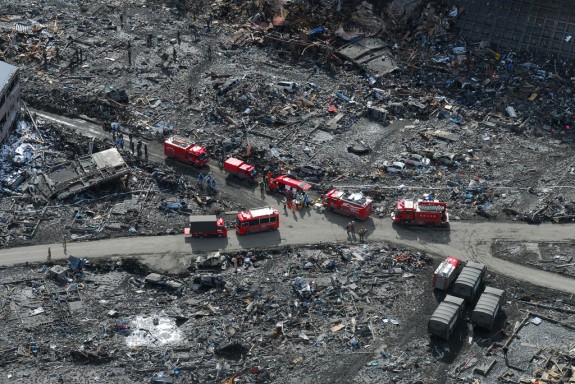The Health Effects of Fukushima’s Radiation Weren’t So Bad
The World Health Organization calculated a barely-there increase in cancer rates

Emergency responders work amidst the rubble from the 2011 Japan tsunami. Photo: U.S. Navy photo by Mass Communication Specialist 3rd Class Dylan McCord
Just a few weeks from now will mark the second anniversary of the nuclear disaster at the Fukushima Daiichi Nuclear Power Plant in Japan, one of the worst nuclear disasters of all time, and only the second since the 1986 Chernobyl disaster to be dubbed a “major accident” by the International Atomic Energy Association. On March 11, 2011, a massive earthquake that hit off the coast spawned a tsunami that took out the power plant’s cooling system, causing the nuclear reactors to overheat and spew radiation high into the atmosphere and into the nearby ocean.
Fear of the radiation was widespread, and a cautionary 20-kilometer exclusion zone was set up around the region. That and other protective efforts, along with a bit of luck, says Nature, reporting on a new study by the World Health Organization, resulted in the increased cancer risk for the nearby population being actually quite small.
The report, drafted by a panel of international experts in radiation risks and public health, concluded that there was no additional cancer risk for the population in most of Japan — even most parts of Fukushima Prefecture — or in neighbouring countries. But the risks were slightly increased in hotspots such as Iitate village and Namie town, which were contaminated by plumes of fallout to the northwest of the plant.
In such hotspots the WHO panel estimated that the fallout has increased the risks of most cancers in children by only a few percent — though for thyroid cancer in young girls the increased risk was put at 70%. These figures are relative risks, however, and the absolute risks are less alarming. For thyroid cancer the baseline lifetime rate in women is 0.75%, so the risk in hotspots would be increased by 0.50%.
Fukushima would have been much worse, says Nature, except that luckily, during the ongoing disaster, the winds blew largely to the northeast, out over the Pacific Ocean. Those winds also made it so that the radiation that made it to the sea got trapped along the shore but, for the most part, not having the radioactive fallout dump overland reduced the effect it could have on humans.
The health consequences of this accident are smaller than Chernobyl because of the very favourable wind direction, out over the Pacific ocean, and the fact that there are no near neighbours,” he says. Tokyo, he adds, is less than 200 km away. “Had the winds prevailed in that direction, Fukushima would have been a whole different story.
That being said, just because the increased cancer risk is on the low end doesn’t mean the Fukushima disaster didn’t do a serious amount of damage. As Christopher Mims argued in The Atlantic last year, the most profound consequences of a nuclear disaster tend to be economic ones as vast stretches of valuable land are abandoned and lives are uprooted.
More from Smithsonian.com:
How The Fukushima Exclusion Zone Shows Us What Comes After The Anthropocene
/https://tf-cmsv2-smithsonianmag-media.s3.amazonaws.com/accounts/headshot/smartnews-colin-schultz-240.jpg)
/https://tf-cmsv2-smithsonianmag-media.s3.amazonaws.com/accounts/headshot/smartnews-colin-schultz-240.jpg)